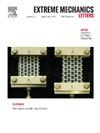Bed-of-Nails effect: Unraveling the insertion behavior of aerosol jet 3D printed microneedle array in soft tissue
IF 4.5
3区 工程技术
Q2 MATERIALS SCIENCE, MULTIDISCIPLINARY
引用次数: 0
Abstract
Implantable biomedical devices often contain rigid components such as microneedles, Si chips, and sensors, that can frequently come in physical contact with soft biological tissue. Brain-computer-interfaces (or BCIs) are an example of such devices where an array of microelectrodes is inserted in the brain to record neuronal activity, stimulate neurons for neuro-prosthetics, and treat neurodegenerative diseases. Recently, CMU Array, a customizable ultra-high-density aerosol jet (AJ) 3D nanoprinted BCI platform was developed by the authors to record action potentials from throughout the 3D volume of the brain. Although the mechanics of insertion of a single sharp needle in biological tissue has been studied, the behavior of an array is still not fully understood. In this paper, we develop a linear elastic model for insertion of multiple microneedles in close proximity with each other and determine the severity of the bed-of-nails effect, when interacting strain fields from neighboring needles fail to cause clean needle insertion into the tissue. We then carry out experiments where an array of 3D-printed and sintered microneedles (80–90 µm diameter, 1 mm long, tip radius of the order of 10 µm) are inserted in agarose, that acts as a phantom brain. We show that our model can predict the experimentally measured peak force, agarose displacement, and energy absorbed during insertion for arrays with microneedles at increasing distance from one another. We show that for our system, the microneedles in the array act completely independent of each other when they are roughly 8–10 needle diameters apart, consistent with the model predictions. This work is fundamental to the understanding of the insertion mechanics and related deformation/damage caused by rigid microscale objects implanted in various soft biological tissue.
Bed-of-Nails效应:揭示气溶胶喷射3D打印微针阵列在软组织中的插入行为
植入式生物医学设备通常包含刚性组件,如微针、硅片和传感器,它们经常与柔软的生物组织发生物理接触。脑机接口(bci)就是这种设备的一个例子,在大脑中插入一组微电极来记录神经元活动,刺激神经元进行神经修复,并治疗神经退行性疾病。最近,作者开发了一种可定制的超高密度气溶胶射流(AJ) 3D纳米打印BCI平台CMU Array,用于记录整个大脑3D体积的动作电位。虽然在生物组织中插入单个尖锐针头的机制已经被研究过,但是阵列的行为仍然没有被完全理解。在本文中,我们建立了一个线性弹性模型,用于多个相互靠近的微针的插入,并确定了当邻近针的相互作用应变场无法导致干净的针插入组织时,钉床效应的严重程度。然后,我们进行了实验,将一系列3d打印和烧结的微针(直径80-90 µm,长1 mm,尖端半径约为10 µm)插入琼脂糖中,作为虚拟大脑。我们表明,我们的模型可以预测实验测量的峰值力、琼脂糖位移和插入过程中微针阵列在彼此之间距离增加时吸收的能量。我们表明,对于我们的系统,阵列中的微针在相距大约8-10针直径时完全相互独立,与模型预测一致。这项工作是理解植入各种软生物组织的刚性微尺度物体所引起的插入力学和相关变形/损伤的基础。
本文章由计算机程序翻译,如有差异,请以英文原文为准。
求助全文
约1分钟内获得全文
求助全文
来源期刊

Extreme Mechanics Letters
Engineering-Mechanics of Materials
CiteScore
9.20
自引率
4.30%
发文量
179
审稿时长
45 days
期刊介绍:
Extreme Mechanics Letters (EML) enables rapid communication of research that highlights the role of mechanics in multi-disciplinary areas across materials science, physics, chemistry, biology, medicine and engineering. Emphasis is on the impact, depth and originality of new concepts, methods and observations at the forefront of applied sciences.
 求助内容:
求助内容: 应助结果提醒方式:
应助结果提醒方式:


